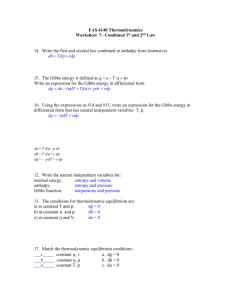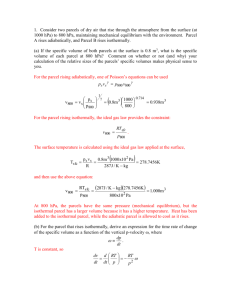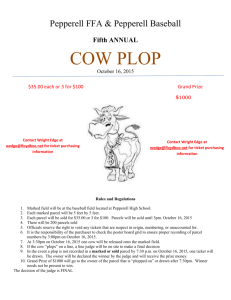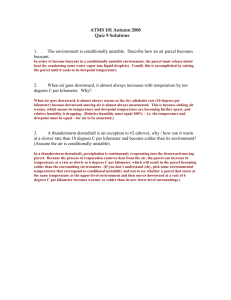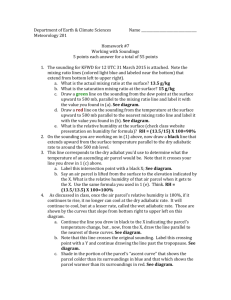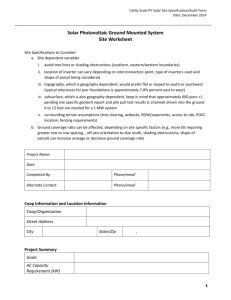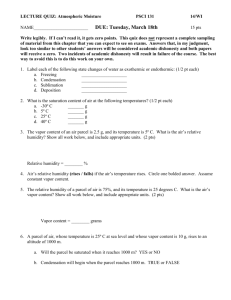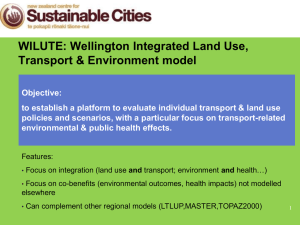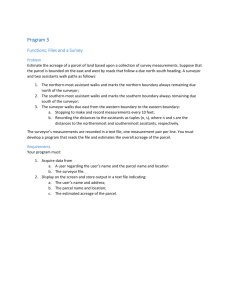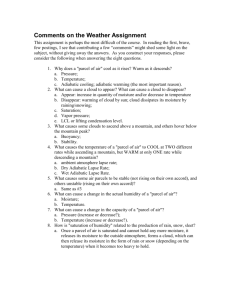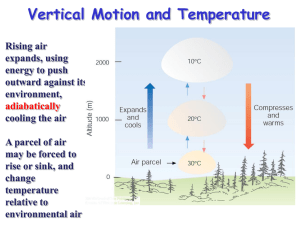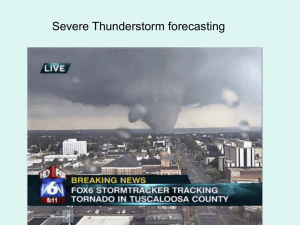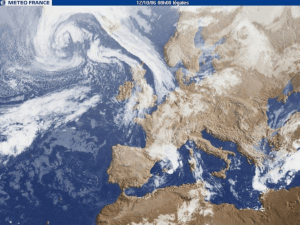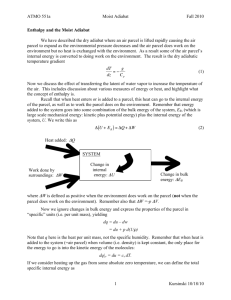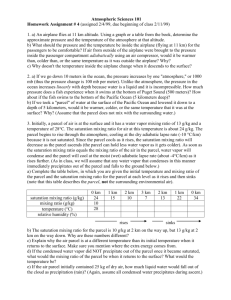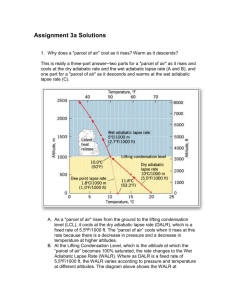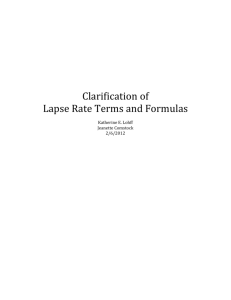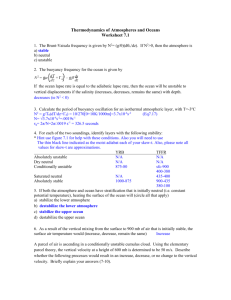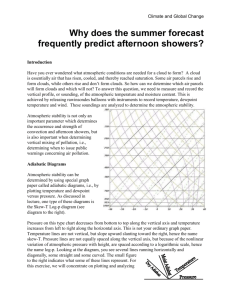DOC
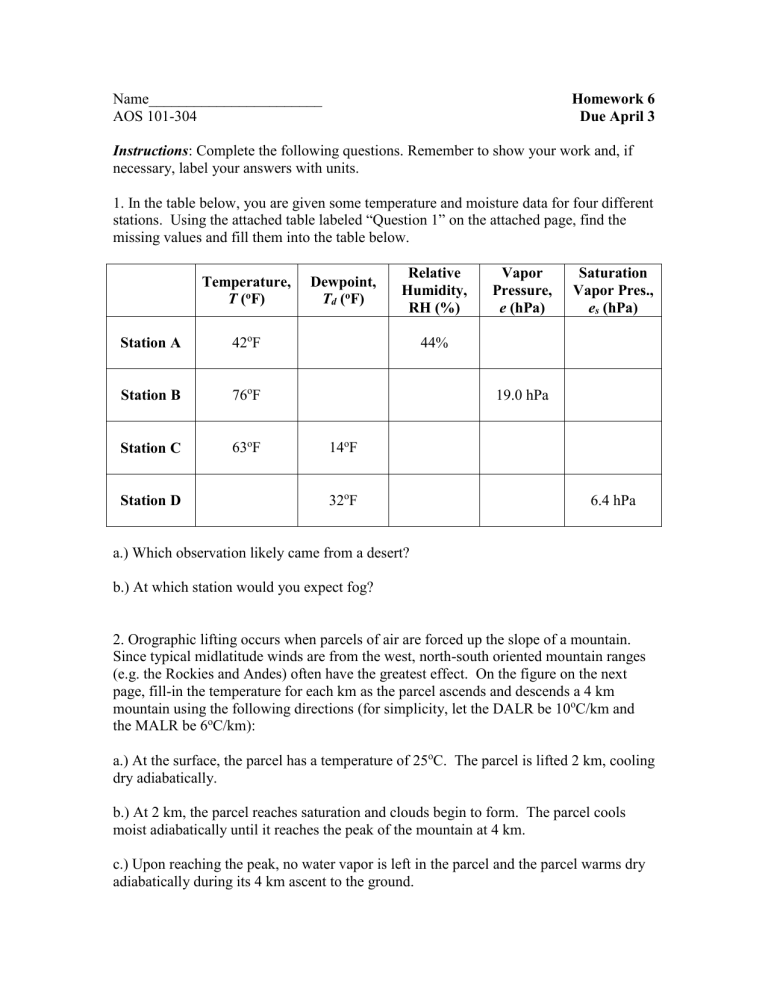
Name_______________________
AOS 101-304
Homework 6
Due April 3
Instructions : Complete the following questions. Remember to show your work and, if necessary, label your answers with units.
1. In the table below, you are given some temperature and moisture data for four different stations. Using the attached table labeled “Question 1” on the attached page, find the missing values and fill them into the table below.
Temperature,
T ( o F)
Dewpoint,
T d
( o F)
Relative
Humidity,
RH (%)
Vapor
Pressure,
e (hPa)
Saturation
Vapor Pres., e s
(hPa)
Station A
Station B
42
76 o o
F
F
44%
19.0 hPa
Station C 63 o
F 14 o
F
Station D 32 o
F a.) Which observation likely came from a desert? b.) At which station would you expect fog?
6.4 hPa
2. Orographic lifting occurs when parcels of air are forced up the slope of a mountain.
Since typical midlatitude winds are from the west, north-south oriented mountain ranges
(e.g. the Rockies and Andes) often have the greatest effect. On the figure on the next page, fill-in the temperature for each km as the parcel ascends and descends a 4 km mountain using the following directions (for simplicity, let the DALR be 10 o
C/km and the MALR be 6 o
C/km): a.) At the surface, the parcel has a temperature of 25 o
C. The parcel is lifted 2 km, cooling dry adiabatically. b.) At 2 km, the parcel reaches saturation and clouds begin to form. The parcel cools moist adiabatically until it reaches the peak of the mountain at 4 km. c.) Upon reaching the peak, no water vapor is left in the parcel and the parcel warms dry adiabatically during its 4 km ascent to the ground.
25 o C d.) Is the surface temperature on the east (leeward/downwind) side of the mountain warmer or cooler than the west (windward/upwind) side of the mountain? e.) On which side would you expect the most precipitation to fall? Why? f.) In the Great Plains, annual precipitation increases as you move east. For instance,
North Platte, NE receives on average 19 inches per year whereas Moline, IL (Quad
Cities) receives 39 inches per year. What geographical factors account for this effect?
3. On a given day, different layers of the atmosphere can have entirely different observed lapse rates and states of stability. Make a graph of temperature vs. height on the grid below using data from the attached table labeled “Question 3”.
0
TEMPERATURE (
10
C) a.) What is the environmental lapse rate of the 0-1 km layer? What kind of stability is observed in this layer? b.) What is the environmental lapse rate of the 1-2 km layer? What kind of stability is observed in this layer? c.) What is the environmental lapse rate of the 4-5 km layer? What kind of stability is observed in this layer? d.) If a surface parcel with initial temperature of 29 o C was risen dry adiabatically to 3 km, what would be the parcel’s new temperature? (use DALR = 10 o
C/km for simplicity) e.) Compare the temperature of this parcel to the observed (environmental) 3 km temperature. Would you expect this parcel to rise or fall once it reached 3 km? Why?
32
33
34
35
28
29
30
31
22
23
24
25
26
27
18
19
20
21
40
41
42
43
44
36
37
38
39
10
11
12
13
14
15
16
17
45
T ( o
Question 1
Saturation Vapor Pressure Table
F) e s
(hPa)
2.4
2.5
2.6
2.7
2.9
3.0
3.1
3.3
3.4
3.6
3.7
3.9
4.0
4.2
4.4
4.6
4.8
5.0
5.2
5.4
5.6
5.9
6.1
6.4
6.6
6.9
7.2
7.5
7.8
8.1
8.4
8.7
9.1
9.4
9.8
10.2
T ( o F)
68
69
70
71
64
65
66
67
58
59
60
61
62
63
54
55
56
57
76
77
78
79
80
72
73
74
75
46
47
48
49
50
51
52
53
81 e s
(hPa)
10.6
11.0
11.4
11.8
12.3
12.7
13.2
13.7
14.2
14.8
15.3
15.9
16.4
17.0
17.7
18.3
19.0
19.6
20.3
21.1
21.8
22.6
23.4
24.2
25.0
25.9
26.8
27.7
28.7
29.6
30.6
31.7
32.7
33.8
35.0
36.1
Question 3
Temperature vs. Height
Ht. (km) T ( o C)
3
4
5
6
7
0
1
2
8
29
18
14
7
0
-8
-13
-17
-24


